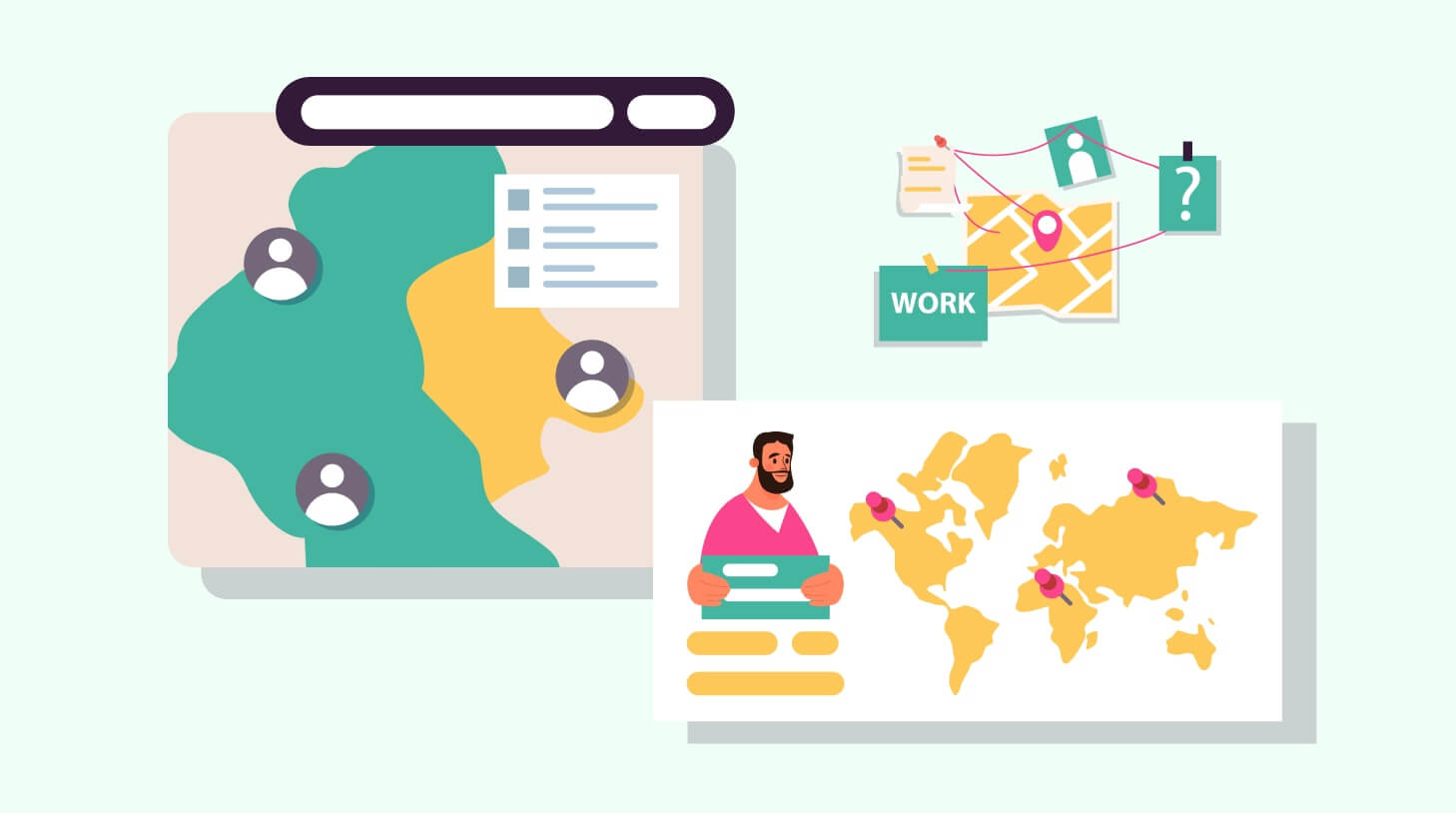Six core onboarding checklists you need for your HR toolkit
A well-structured onboarding process offers significant advantages for both new hires and organizations. We prepared for you six important checklists that will make your HR work a lot easier.

According to a study by the Society for Human Resource Management (SHRM), companies with standard onboarding processes see a 50% increase in productivity among new employees.
This immediate boost in productivity can be attributed to clear guidance, structured training, and the provision of necessary resources from the outset.
Additionally, research by BambooHR indicates that employees who feel they had an effective onboarding experience are 18 times more likely to feel committed to their organization.
This heightened sense of commitment is crucial for fostering long-term loyalty and reducing turnover rates.
How can you make the onboarding process smoother and more efficient? Explore our six core onboarding checklists and experience the positive impact in your company.
Contents
1. New employee checklist
The New Employee Checklist is designed to ensure that all essential tasks are completed before the new hire’s first day.
This checklist covers everything from sending the offer letter to preparing the workspace, ensuring a smooth transition into the company.
By following this checklist, you can create a welcoming environment and provide new employees with the resources they need to start their new role confidently.
Here’s what you need to do:
|
Practical Stuff |
Who will do it? |
Date to be completed |
|
Offer letter and/or welcome email with starting day info |
HR |
Within 24 hours of verbal offer acceptance |
|
Paylocity, Onboarding message sent |
HR |
Collect all their personal info and print out I-9 for orientation |
|
Paylocity, payroll info and identification |
HR |
Before start date |
|
Seat/space to be allocated |
Department manager |
On acceptance of role |
|
Desk, Chair or work bench |
Department manager |
Ready before start date |
|
Office supplies |
Manager |
Ready before start date |
|
Internal Telephone – which extension will be allocated |
IT Dept |
Completed before start date |
|
Telephone list updated |
IT Dept |
Completed before start date |
|
IT equipment – Computer, mouse, keyboard, screen, cables, etc. |
Dept Manager notifies IT Manager of employee’s needs via helpdesk ticket |
Ready to go for day one |
|
Software needs |
Dept Manager notifies IT Manager of employee’s needs via helpdesk ticket |
Ready to go for day one |
|
Printer connection |
Dept Manager notifies IT Manager of employee’s needs via helpdesk ticket |
Ready to go for day one |
|
Email account set up |
Dept Manager notifies IT Manager of employee’s needs via helpdesk ticket |
Ready to go for day one |
|
Server – user rights access |
Dept Manager notifies IT Manager of employee’s needs via helpdesk ticket |
Ready to go for day one |
2. New hire checklist: before the first day
While the above provides a comprehensive checklist for new hires, the following one delves deeper into what you should do before the first day of work.
Preparing for a new hire’s arrival involves several critical steps to ensure they feel welcomed and ready to start their new role.
This proactive approach helps to streamline the onboarding process and ensures all administrative tasks are handled efficiently before the new employee’s first day.
|
Task |
Details |
|
Prepare and send employment contract |
Includes job information, work schedule, length of employment, compensation and benefits, employee responsibilities, termination conditions |
|
Send offer letter |
Job title, department, direct report, work schedule, start date, compensation, benefits, length of employment, response date |
|
Complete legal employment forms |
W-4 form, I-9 form, State Tax Withholding form, Direct Deposit form, E-Verify system |
|
Prepare and obtain signatures on internal forms |
Non-compete agreements, non-disclosure agreements, employee invention forms, employee handbook acknowledgement forms, drug/alcohol test consent agreements, job analysis forms, employee equipment inventory lists, confidentiality and security agreements |
|
Prepare employee benefits documents |
Life and health insurance, mobile plan, company car, stock options, retirement plan, disability insurance, paid time off/vacation policies, sick leave, employee wellness perks, tuition reimbursement |
|
Obtain employees’ personal data |
Emergency contacts, brief medical history, food allergies or preferences |
3. New hire first day checklist
The first day of a new hire sets the tone for their future with the company. The New Hire First Day Checklist focuses on making the first day as smooth and welcoming as possible.
This checklist includes greeting the new hire, giving an office tour, helping with initial HR paperwork, and providing an overview of company policies. By carefully planning the first day, you help new employees feel comfortable and ready to begin their journey with your organization.
HR team tasks
|
Task |
Details |
|
Prepare new hire’s workstation |
Include employee handbook, onboarding kit, welcome letter, first-day agenda, nameplate, business cards, office equipment |
|
Enthusiastically greet new hire |
Could be done by HR member, office manager, or new hire’s manager |
|
Office tour |
Show different departments and common areas |
|
Fill out HR paperwork |
Provide and explain forms |
|
Present company policies |
Explain employment agreement terms and benefits |
|
End-of-day check-in |
Ask about their first day, clarify policies, check if they have everything needed, answer questions |
Hiring manager tasks
|
Task |
Details |
|
Introduce new hire |
To team members and company via email or messaging software |
|
Ensure computer station setup |
Check accounts, software installations, and provide manuals |
|
Role-specific training |
Main responsibilities, team structure, job-specific tools, team objectives |
|
Schedule meetings |
With team leaders and colleagues |
|
Assign first tasks |
Offer guidance, provide resources, clarify questions |
|
Assign work buddy |
Help new hire adjust |
|
Group lunch |
To get to know colleagues |
|
Overview of first week/month |
Provide details and set aside time for questions |
4. New hire paperwork checklist
Completing all necessary paperwork is a crucial part of the onboarding process. The New Hire Paperwork Checklist ensures that all required documents, both legal and internal, are prepared and signed. This includes employment contracts, tax forms, and benefit documents.
Properly managing paperwork helps in maintaining compliance and sets clear expectations between the employer and the new hire.
|
Task |
Details |
|
Prepare and send employment contract |
Includes job information, work schedule, length of employment, compensation and benefits, employee responsibilities, termination conditions |
|
Complete legal employment forms |
W-4 form (or W-9 for contractors), I-9 form, State Tax Withholding form, Direct Deposit form, E-Verify system |
|
Obtain signatures on internal forms |
Non-compete agreements, non-disclosure agreements, employee invention forms, employee handbook acknowledgement forms, drug/alcohol test consent agreements, job analysis forms, employee equipment inventory lists, confidentiality and security agreements |
|
Prepare employee benefits documents |
Life and health insurance, mobile plan, company car, stock options, retirement plan, disability insurance, paid time off/vacation policies, sick leave, employee wellness perks, tuition reimbursement |
|
Obtain personal data for emergencies |
Emergency contacts, brief medical history, food allergies or preferences |
5. New employee orientation program checklist
Orientation is a key component of the onboarding process, helping new hires acclimate to their new work environment and understand company policies.
The New Employee Orientation Program Checklist guides you through the tasks needed to support new employees during their first few days.
This includes administrative support, an overview of company policies, office tours, and introductions to team members. A comprehensive orientation program helps new hires integrate smoothly and quickly into their new roles.
|
Task |
Details |
|---|---|
|
Fill out HR paperwork |
I-9 form, W-4 form, employee acknowledgement and consent form, background check form, direct deposit form |
|
Explain procedures |
Entering/leaving the building, placing orders, requesting time off |
|
Arrange for staff photos |
For badge, business card, or online avatar |
|
Provide employee uniform |
If applicable |
|
Explain employment agreement terms |
Non-disclosure agreement, non-compete agreement, confidentiality agreement, employee invention agreement |
|
Provide resources on perks and benefits |
Health and life insurance, mobile plan reimbursement, company car policy, stock options guide, training program guide, performance bonus guide, employee wellness program |
|
Overview of company policies |
Vacation/paid time off, work from home, sick leave, safety guidelines, absenteeism, data security |
|
Explain a typical day at the office |
Regular work times, breaks, lunch options |
|
Provide employee handbook |
Answer any questions |
|
Office tour |
Show departments and common areas |
|
Point out key contacts |
Direct manager, HR team, IT team, office manager |
|
Introduce to teams |
Schedule meetings with colleagues and team leaders |
|
Show meeting rooms |
Explain booking process |
|
Indicate emergency exits |
|
|
Schedule teamwide meetup |
Group lunch or after-hours drinks |
|
Assign work buddy or mentor |
Assist with onboarding tasks and questions |
6. IT onboarding checklist
A seamless IT setup is essential for new hires to start their roles without technical hitches. The IT Onboarding Checklist details the steps required to prepare all necessary technology and accounts before the new hire’s arrival.
It also includes instructions for the first day and ongoing support to ensure new employees have everything they need from a technical perspective.
Efficient IT onboarding helps new hires be productive from day one and reduces the likelihood of technical issues disrupting their workflow.
Before the first day
|
Task |
Details |
|
Coordinate with HR and hiring manager |
Collect new hire information (names, contact details, job titles, departments, starting dates, software needs) |
|
Order equipment |
Laptop or desktop, monitor, mouse, keyboard, cables, USB sticks, phone |
|
Determine software, tools, access rights |
Company email, internal messaging, productivity tools, analytics, spreadsheets |
|
Get approval for new accounts |
From senior management |
|
Invite new hires to corporate accounts |
Send setup guidelines |
|
Contact new hires/hiring managers |
Learn preferred tech equipment (if applicable) |
On the first day
|
Task |
Details |
|
Prepare workstation |
Computer, phone, printer |
|
Schedule 1:1 meetings |
Set up company accounts (email, messaging app, password security tools) |
|
Provide manuals |
For hardware and software |
|
Explain corporate office equipment use |
Projectors, video conference tools, printers, fax machines |
|
Ensure data privacy agreements are signed |
|
|
Describe visitors policy |
|
|
Train on securing workstations |
Store physical/digital files, share sensitive data, lock computer and desk |
|
Explain how to reach IT |
Location, email, phone, username for messaging apps, formal procedure for assistance |
First week or month
|
Task |
Details |
|
Check in with new hires |
Ensure software installation |
|
Schedule necessary trainings |
Security policies, best practices for office equipment, productivity tips for tools |
|
Answer specific questions |
Address issues or questions after using tools |
|
Sign up for routine security training |
Implementing comprehensive onboarding checklists is a vital step toward fostering a productive and committed workforce. By systematically addressing each aspect of the onboarding process—from pre-arrival preparations to first-day introductions, ongoing support, and technical setup—organizations can ensure that new hires feel welcomed, informed, and equipped to succeed in their roles.
As evidenced by research, investing in effective onboarding is not merely a procedural necessity but a strategic imperative that drives organizational success and growth.
By following these checklists, companies can create a positive and lasting impact on their new employees, setting the stage for a mutually rewarding professional journey.
Frequently asked questions
- What are the benefits of using onboarding checklists?
- Onboarding checklists streamline the process, ensuring all necessary tasks are completed, which boosts new hire productivity by 50%, according to SHRM. They help create a welcoming environment, provide necessary resources from day one, and foster long-term commitment, reducing turnover rates.
- How do these checklists improve new hire productivity?
- According to SHRM, companies with standard onboarding processes see a 50% increase in new hire productivity. Clear guidance, structured training, and resource provision from the outset help new employees acclimate quickly, enhancing their efficiency and contribution to the organization.
- Why is a New Employee Checklist important?
- A New Employee Checklist ensures all essential tasks are completed before the new hire's first day, from sending the offer letter to preparing the workspace. This thorough preparation creates a welcoming environment and provides new employees with the confidence and resources to start their role effectively.
- What should be done before the new hire's first day?
- Before the first day, tasks include sending the employment contract, offer letter, and legal forms, preparing benefits documents, and collecting personal data. These steps ensure all administrative tasks are handled efficiently, making the new hire feel welcomed and ready to start.
- How does an effective onboarding process affect employee commitment?
- Research by BambooHR shows that employees who feel they had an effective onboarding experience are 18 times more likely to feel committed to their organization. This heightened commitment is crucial for fostering long-term loyalty and reducing turnover rates.




